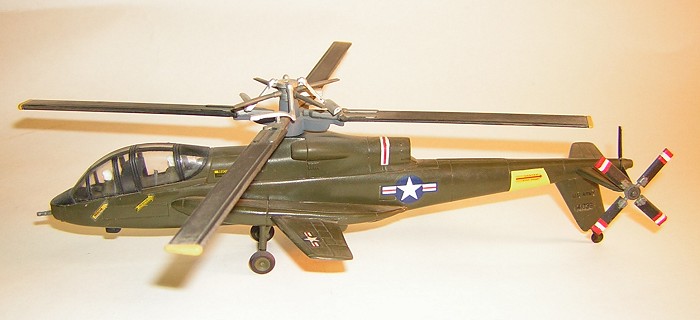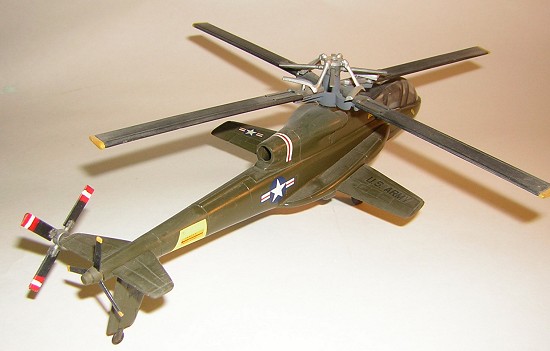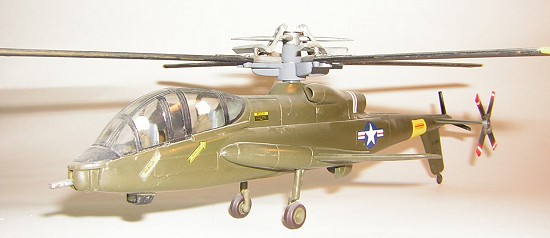
Aurora's 1/72 AH-56A Cheyenne
| KIT #: | ? |
| PRICE: | $.98 when new back in the 60s. |
| DECALS: | one option |
| REVIEWER: | Joel Hamm |
| NOTES: | Something of a collector's item |

| HISTORY |
This review is just a quickie for the sake of fun and nostalgia. Show of hands, please, how many of you out there remember Aurora Models? Yup, thought so. Many of us oldie-moldy modelers started out on Auroras. They were a step above Hawk, one below Monogram, and half a league at least behind Revell, which was the Cadillac of polystyrene before Airfix crossed the Atlantic or the Japanese jumped into the business.
 Fit, finish, and ease of
assembly were their appeal, as they catered to the kiddie set (well, so did
everyone. Grownups didn’t “play” with models back then – or at least they
didn’t admit to it.) As far as accuracy was concerned, “Close enough is
close enough” seemed to be their philosophy. A reasonable representation
was the best that could be expected. Interior detail typically consisted of
a disembodied pilot’s head molded to a blanked out cockpit. Excitement of
subject was also high on their priority list; which is probably why they
chose to do the somewhat esoteric Cheyenne just before closing shop around
1978.
Fit, finish, and ease of
assembly were their appeal, as they catered to the kiddie set (well, so did
everyone. Grownups didn’t “play” with models back then – or at least they
didn’t admit to it.) As far as accuracy was concerned, “Close enough is
close enough” seemed to be their philosophy. A reasonable representation
was the best that could be expected. Interior detail typically consisted of
a disembodied pilot’s head molded to a blanked out cockpit. Excitement of
subject was also high on their priority list; which is probably why they
chose to do the somewhat esoteric Cheyenne just before closing shop around
1978.
Anyone interested in the H-56’s background can Google it and end up with a dozen or more pages, much of it contradictory, and some downright asinine. When it comes to authenticity, the Web isn’t exactly Encyclopedia Britannica. Anyone can publish anything and then become the basis for someone else’s “research” which eventually become well established “fact”; sort of like urban legends. Which is why several sources claimed the Cheyenne was the successor the AH-1 Cobra. I’m pretty sure it was the other way around, but ‘course I ain’t no expert neither.
I do remember first
learning of the Cheyenne back in the late ‘60s on one of the morning “news”
shows. With much fanfare it was ballyhooed as the ultimate
“anti-insurgency” instrument. Like so many other ultimates, it never met
expectations and faded into obscurity. It supposedly sported a host of
innovations (mind you, I’m just recapping what I’ve read and make no
 claims for authenticity.
Anyone truly in the know is invited to chime in on the Readers Forum and
give us the Truth, the Whole Truth, and Nothing But the Truth about the
a/c.)
claims for authenticity.
Anyone truly in the know is invited to chime in on the Readers Forum and
give us the Truth, the Whole Truth, and Nothing But the Truth about the
a/c.)
A “rigid rotor system”, which I suppose means no lead/lag or flapping hinges as in articulated rotors, allowed it to do acrobatics. The op-cited news show had films of it looping and rolling, which gave me the willies just sitting there watching. Whirlymaflopters aren’t supposed to do things like that. At cruise speeds power was diverted from the main rotor to the pusher prop shooting speed up to (according to one source) a searing 400 kts. Lift in that condition was generated by the stub wings and gyroplaning rotor. Why a weapon with those potentials never reached fruition isn’t made clear, though it did suffer a string of crashes; one in which the rotor sliced through the fuselage, indicating that it was perhaps not as rigid as hoped. In any event, we now have the AH64 Apache so all was not for naught.
| THE KIT |
Overall resemblance
to the actual aircraft was OK, except in several areas. The canopy is too
narrow. The real one was wider from the top down, allowing t he
crew to peer earthward. The stub wings should be swept; the rotor head and
assorted arms are simplified and too massive; the blades too long. The
gear legs are the size of mature oaks. Other than that, thinks are
acceptable for a 12-year-old builder.
he
crew to peer earthward. The stub wings should be swept; the rotor head and
assorted arms are simplified and too massive; the blades too long. The
gear legs are the size of mature oaks. Other than that, thinks are
acceptable for a 12-year-old builder.
| CONSTRUCTION |
Can’t remember that far back; but looking at the model, it seems to have gone together straight out of the box without need for filling or fiddling; which must be the case since I hadn’t the nerve back then to tamper with a precious $.98 kit.
| COLORS & MARKINGS |
Neither had I the courage to paint, so it is left in OD plastic, except for a brush coating on the rotor blades and arms. Decals, thick as they must have been, have stuck tight through all these years of dust and dryness, without setting fluids or overcoats.
| CONCLUSIONS |
 Certainly no work of art
– only a reminder of our youth. I suppose it can serve as a base for an
accurizing re-build; but that might ruin any sentimental or collector
value. Besides – it’s simply not worth it. One of the limited editioners is
bound eventually to issue a decent version.
Certainly no work of art
– only a reminder of our youth. I suppose it can serve as a base for an
accurizing re-build; but that might ruin any sentimental or collector
value. Besides – it’s simply not worth it. One of the limited editioners is
bound eventually to issue a decent version.
P.S. Trippers down Memory Lane can Web into http://www.majormattmason.net/aurora/ and reminisce on the full line of Aurora kits.
August 2005
Editor's Note: There is an excellent Warplane Tech book on the AH-56 that is well worth obtaining if you wish more information on this interesting helo.
If you would like your product reviewed fairly and quickly, please contact me or see other details in the Note to Contributors.